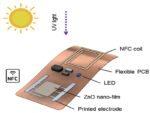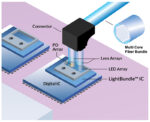Zinc oxide (ZnO) is a common ingredient in sunscreen lotions. Less well-known is the fact that it’s also a wide band gap (WBG) semiconductor (3.4 eV). As a nanomaterial, ZnO is being used to develop a wide variety of sensor technologies. Sensor applications for ZnO include health monitoring, chemical sensing, biomedical, and environmental sensors. Some […]
What is hyperspectral imaging?
Hyperspectral imaging is the most comprehensive of the three common image processing technologies. The other two technologies are red-green-blue (RGB) imaging and multispectral imaging. All three are noninvasive and nondestructive and give engineers and scientists different ways to analyze objects. RGB imaging can be quick and inexpensive to implement and provides basic information about an […]
How does OPC UA PubSub data support connector digital twins?
The use of digital twins can be an important factor in maximizing the performance and flexibility of Industry 4.0 factories. Open Platform Communications (OPC) is the interoperability standard for the secure and reliable exchange of data in industrial automation environments. OPC has been expanded to include the unified architecture (UA), standardized as IEC 62541, that […]
How do connectors made with conductive plastics contribute to sustainability?
Basic plastics are electrically insulating, but with the proper additives, they can become conductive. Electrically conductive plastics can be used to replace metal components and improve sustainability in several areas of connector construction. They take less energy to fabricate and are lighter, reducing system weight, a very important consideration in applications like electric vehicles (EVs). […]
How does UCIe on chiplets enable optical interconnects in data centers?
Chiplets enable heterogeneous integration of various process nodes and materials to maximize performance. UCIe is a new die-to-die interconnect standard for high-bandwidth, low-latency, power-efficient, and cost-effective connectivity between chiplets. UCIe is also the first specification to include an interface that is compatible with optical links. Large computing systems needed to support high-performance computing (HPC) applications […]
What is the best copper alloy for connectors in renewable energy and EV applications?
Copper is important in supporting renewable energy and electric vehicles (EVs). For example, there’s about 5.5 tons of copper used per megawatt (MW) of photovoltaic generation and there’s 183 pounds of copper in an EV, compared with only 48 pounds in an internal combustion engine (IEC) vehicle. Not all copper is the same; there’s a […]
What are the challenges when testing chiplets?
Chiplet testing begins with performance simulations during the design process. Compared with monolithic devices, heterogeneous chiplets require more complex testing, including known good die (KGD) testing, final test, and system level test. Success also depends on the implementation of design for test (DfT) based on several IEEE standards. Chiplet designers need high-speed tools that can […]
How can in-package optical interconnects enhance chiplet generative AI performance?
Generative artificial intelligence (AI) requires rapid and continuous movement of large amounts of data. In a growing number of instances, electrical input/output (I/O) connections between the ICs in chiplets are becoming a bottleneck to higher performance. Key electrical I/O performance barriers include power efficiency, bandwidth, and latency. This FAQ looks at the anticipated benefits of […]
How can carbon nanotubes improve interconnect performance?
Carbon nanotubes (CNTs) have been proposed for reducing fretting wear in connectors used in high-vibration environments like vehicles. They can also be used to make contacts with lower contact resistance and higher corrosion resistance compared with silver (Ag) plating, and they have been used to reduce the weight in some shielded cables by 25% or […]
How do UCIe and BoW interconnects support generative AI on chiplets?
The bunch-of-wires (BoW) and Universal Chiplet Interconnect Express (UCIe) standards provide designers with tradeoffs in terms of throughput, interconnect density, delay, and bump pitch. This FAQ compares the performance of BoW and UCIe and looks at how optical interconnects may provide a path to even higher performance interconnects in chiplets. To realize optimal performance for […]











